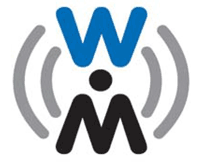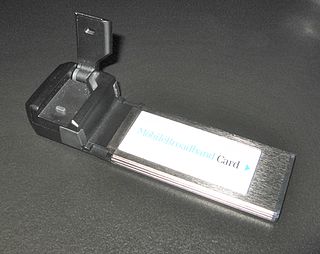
Wireless broadband is a telecommunications technology that provides high-speed wireless Internet access or computer networking access over a wide area. The term encompasses both fixed and mobile broadband.

IEEE 802.11 is part of the IEEE 802 set of local area network (LAN) technical standards, and specifies the set of medium access control (MAC) and physical layer (PHY) protocols for implementing wireless local area network (WLAN) computer communication. The standard and amendments provide the basis for wireless network products using the Wi-Fi brand and are the world's most widely used wireless computer networking standards. IEEE 802.11 is used in most home and office networks to allow laptops, printers, smartphones, and other devices to communicate with each other and access the Internet without connecting wires. IEEE 802.11 is also a basis for vehicle-based communication networks with IEEE 802.11p.

In telecommunications, orthogonal frequency-division multiplexing (OFDM) is a type of digital transmission used in digital modulation for encoding digital (binary) data on multiple carrier frequencies. OFDM has developed into a popular scheme for wideband digital communication, used in applications such as digital television and audio broadcasting, DSL internet access, wireless networks, power line networks, and 4G/5G mobile communications.

Worldwide Interoperability for Microwave Access (WiMAX) is a family of wireless broadband communication standards based on the IEEE 802.16 set of standards, which provide physical layer (PHY) and media access control (MAC) options.
4G is the fourth generation of broadband cellular network technology, succeeding 3G and preceding 5G. A 4G system must provide capabilities defined by ITU in IMT Advanced. Potential and current applications include amended mobile web access, IP telephony, gaming services, high-definition mobile TV, video conferencing, and 3D television.

Evolution-Data Optimized is a telecommunications standard for the wireless transmission of data through radio signals, typically for broadband Internet access. EV-DO is an evolution of the CDMA2000 (IS-2000) standard which supports high data rates and can be deployed alongside a wireless carrier's voice services. It uses advanced multiplexing techniques including code-division multiple access (CDMA) as well as time-division multiplexing (TDM) to maximize throughput. It is a part of the CDMA2000 family of standards and has been adopted by many mobile phone service providers around the world particularly those previously employing CDMA networks. It is also used on the Globalstar satellite phone network.

IEEE 802.16 is a series of wireless broadband standards written by the Institute of Electrical and Electronics Engineers (IEEE). The IEEE Standards Board established a working group in 1999 to develop standards for broadband for wireless metropolitan area networks. The Workgroup is a unit of the IEEE 802 local area network and metropolitan area network standards committee.
BT Broadband is a broadband service offered by BT Consumer; a division of BT Group in the United Kingdom. It was formerly known as BT Total Broadband, BT Yahoo! Broadband and BT Openworld. With the introduction of BT Infinity, the Broadband package now refers to the legacy ADSL broadband products, such as ADSL Max and ADSL2+.

Orthogonal frequency-division multiple access (OFDMA) is a multi-user version of the popular orthogonal frequency-division multiplexing (OFDM) digital modulation scheme. Multiple access is achieved in OFDMA by assigning subsets of subcarriers to individual users. This allows simultaneous low-data-rate transmission from several users.

A home network or home area network (HAN) is a type of computer network that facilitates communication among devices within the close vicinity of a home. Devices capable of participating in this network, for example, smart devices such as network printers and handheld mobile computers, often gain enhanced emergent capabilities through their ability to interact. These additional capabilities can be used to increase the quality of life inside the home in a variety of ways, such as automation of repetitive tasks, increased personal productivity, enhanced home security, and easier access to entertainment.
Qualcomm Atheros is a developer of semiconductor chips for network communications, particularly wireless chipsets. The company was founded under the name T-Span Systems in 1998 by experts in signal processing and VLSI design from Stanford University, the University of California, Berkeley, and private industry. The company was renamed Atheros Communications in 2000 and it completed an initial public offering in February 2004, trading on the NASDAQ under the symbol ATHR.

The WiMedia Alliance was a non-profit industry trade group that promoted the adoption, regulation, standardization and multi-vendor interoperability of ultra-wideband (UWB) technologies. It existed from about 2002 through 2009.

Fritz!Box, stylised as FRITZ!Box, is a series of residential gateway devices produced by the German company AVM GmbH. In 2010 it was estimated the series had a market share of 68% of the digital subscriber line (DSL) consumer equipment in Germany.
A wide variety of different wireless data technologies exist, some in direct competition with one another, others designed for specific applications. Wireless technologies can be evaluated by a variety of different metrics of which some are described in this entry.

Mobile broadband is the marketing term for wireless Internet access via mobile (cell) networks. Access to the network can be made through a portable modem, wireless modem, or a tablet/smartphone or other mobile device. The first wireless Internet access became available in 1991 as part of the second generation (2G) of mobile phone technology. Higher speeds became available in 2001 and 2006 as part of the third (3G) and fourth (4G) generations. In 2011, 90% of the world's population lived in areas with 2G coverage, while 45% lived in areas with 2G and 3G coverage. Mobile broadband uses the spectrum of 225 MHz to 3700 MHz.

In radio, multiple-input and multiple-output (MIMO) is a method for multiplying the capacity of a radio link using multiple transmission and receiving antennas to exploit multipath propagation. MIMO has become an essential element of wireless communication standards including IEEE 802.11n, IEEE 802.11ac, HSPA+ (3G), WiMAX, and Long Term Evolution (LTE). More recently, MIMO has been applied to power-line communication for three-wire installations as part of the ITU G.hn standard and of the HomePlug AV2 specification.
International Mobile Telecommunications-Advanced are the requirements issued by the ITU Radiocommunication Sector (ITU-R) of the International Telecommunication Union (ITU) in 2008 for what is marketed as 4G mobile phone and Internet access service.

WiGig, alternatively known as 60 GHz Wi-Fi, refers to a set of 60 GHz wireless network protocols. It includes the current IEEE 802.11ad standard and also the IEEE 802.11ay standard.
IEEE 802.11ac-2013 or 802.11ac is a wireless networking standard in the IEEE 802.11 set of protocols, providing high-throughput wireless local area networks (WLANs) on the 5 GHz band. The standard has been retroactively labelled as Wi-Fi 5 by Wi-Fi Alliance.
IEEE 1905.1 is an IEEE standard which defines a network enabler for home networking supporting both wireless and wireline technologies: IEEE 802.11, IEEE 1901 power-line networking, IEEE 802.3 Ethernet and Multimedia over Coax (MoCA).














